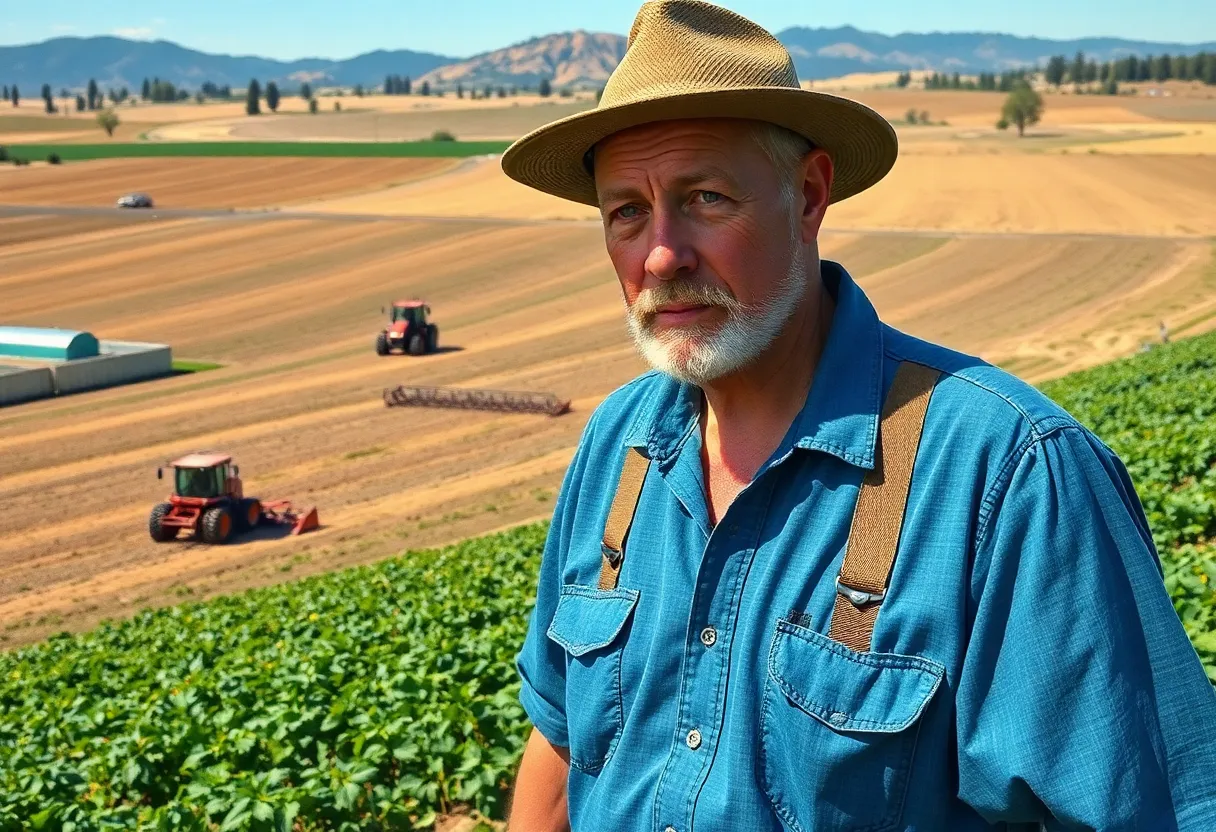California, August 26, 2025
News Summary
California farmers are dealing with a severe labor crisis intensified by immigration raids and a shift towards automation. With around 88,000 agricultural jobs unfilled each year, farmers like Larry Jacobs are unable to find enough laborers, forcing them to consider technology alternatives. As reported, recent immigration enforcement actions have resulted in fear among potential workers, leading to significant impacts on agricultural productivity. While automation presents a potential solution, outdated regulations surrounding technology pose additional challenges.
California farmers are facing a labor crisis exacerbated by recent immigration raids and a push toward technology to fill the gap. With nearly 88,000 agricultural jobs unfilled annually in the U.S., many farmers find themselves in a dilemma—either adapt to new methods of farming or face crippling labor shortages.
Larry Jacobs, a farmer in Central California, highlights this issue, struggling to find enough laborers to work his fields. Following several immigration enforcement actions, reports indicate at least 35 arrests in Ventura County farms, which has contributed to workers staying home out of fear of being apprehended. This has resulted in a significant impact on the agricultural output in the region.
In response to the dwindling workforce, Jacobs has turned to automation, employing robots to handle various tasks around his farm. This shift allows him to maintain operations with half the previous human workforce. The choice for technology appears to be a feasible solution, especially as Bonsai Robotics offers machines that cost about $13,000 compared to the roughly $80,000 required for conventional tractors. This not only reduces costs but also enhances efficiency in managing crops.
However, California’s current regulations prohibit the use of autonomous machines without human oversight, a restriction many argue is outdated. The regulations were devised in the 1970s, and there is a growing push for their revision to keep pace with technological advancements. Tyler Niday, CEO of Bonsai Robotics, emphasizes the need for legislative adjustments to allow for more effective use of automation in agriculture.
The average age of farmers in California is now 58, prompting hopes that enhanced automation could attract younger individuals to the agricultural sector. Nonetheless, the transition to a more automated workforce is met with skepticism by some industry insiders. Critics point out that essential agricultural tasks, mainly those involving delicate crops like strawberries, still necessitate a human touch, making complete automation impractical.
A notable portion, about 42%, of U.S. crop farmworkers lack work authorization, with California leading in the percentage of unauthorized workers. Agriculture Secretary Brooke Rollins has indicated that leveraging automation and making reforms in current labor structures are part of the strategy to tackle labor shortages. She suggested that able-bodied adults on Medicaid could fill these roles, a comment that ignited strong criticisms from within California’s agriculture community, deeming it both unrealistic and insulting.
Manuel Cunha, a representative of the Nisei Farmers League, points to previous failed attempts to recruit individuals from welfare programs, suggesting these efforts led to crop failures and financial losses. In tandem, there are critiques asserting that current immigration policies threaten food security. If the labor crisis persists, it could jeopardize agricultural productivity essential for the nation’s food supply.
The Trump administration has acknowledged these challenges, filing requests for temporary visa programs to allow foreign workers into the agricultural sector to help alleviate workforce shortages. Many express a desire to engage in discussions with the administration about addressing labor needs for essential migrant workers not only in agriculture but also in service industries.
In summary, California’s agricultural labor crisis underlines the critical intersection between immigration policy, workforce requirements, and food security. A reevaluation of both labor sources and regulations surrounding automation could be essential in supporting the industry through these challenging times.
FAQ
What labor issues are California farmers facing?
California farmers are struggling with significant labor shortages, exacerbated by recent immigration raids which have caused fear among workers and led to many not showing up for work. Approximately 88,000 agricultural jobs remain unfilled each year in the U.S.
How is technology being used to address the labor crisis?
Farmers are increasingly turning to automation, like robots for various farming tasks. This allows them to maintain operations with fewer human workers, as automation technology becomes more affordable and efficient.
What are the regulatory challenges with automation in agriculture?
Current California regulations require human oversight for autonomous machines, which many find outdated. There is a call for reform to better integrate technology into farming practices.
What percentage of farmworkers in the U.S. lack work authorization?
Approximately 42% of U.S. crop farmworkers are unauthorized, with California having the highest share of unauthorized workers.
Key Features of the Labor Crisis in California Agriculture
| Feature | Details |
|---|---|
| Labor Shortages | 88,000 agricultural jobs unfilled annually in the U.S. |
| Adoption of Technology | Automation used to reduce labor dependency; technology cost-effectiveness. |
| Current Regulations | California prohibits autonomous machines without human oversight. |
| Market Conditions | High percentage of unauthorized farmworkers; increased fear due to immigration raids. |
| Future Outlook | Discussions around legalizing migrant workers; potential temporary visa programs proposed. |
Deeper Dive: News & Info About This Topic
- Los Angeles Times: No Amnesty for Farmworkers
- Future Farming: Agricultural Robotics Market Growth
- The Guardian: Trump on Agriculture and Migrant Workers
- CBS News: Farming Automation and Migrant Workers
- Ag Proud: California Dairy and Automation
- Wikipedia: Agriculture in California
- Google Search: California Agricultural Labor Crisis
- Google Scholar: California Agriculture Labor Automation
- Encyclopedia Britannica: Agriculture
- Google News: California Farm Labor Crisis

Author: Anaheim Staff Writer
The Anaheim Staff Writer represents the experienced team at HEREAnaheim.com, your go-to source for actionable local news and information in Anaheim, Orange County, and beyond. Specializing in "news you can use," we cover essential topics like product reviews for personal and business needs, local business directories, politics, real estate trends, neighborhood insights, and state news affecting the area—with deep expertise drawn from years of dedicated reporting and strong community input, including local press releases and business updates. We deliver top reporting on high-value events such as major conventions at the Anaheim Convention Center, including NAMM and VidCon, exciting games at Angel Stadium and Honda Center, and developments at Disneyland Resort Our coverage extends to key organizations like the Anaheim Chamber of Commerce and Visit Anaheim, plus leading businesses in hospitality, entertainment, and innovation that power the local economy As part of the broader HERE network, including HERECostaMesa.com, HEREHuntingtonBeach.com, HERESantaAna.com, and HERELosAngeles.com, we provide comprehensive, credible insights into Southern California's dynamic landscape.




